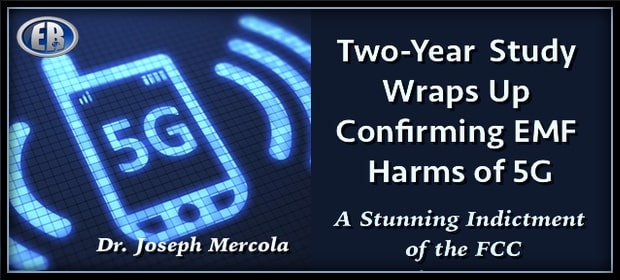
5G Harms Humans, Animals, Plants, Landmark Study Shows
In the race for hyperfast internet speed and connectivity, experts are making comparisons between the release of 5G and the lies told by the tobacco and oil industries.
DR. JOSEPH MERCOLA
Miss a day, miss a lot. Subscribe to The Defender’s Top News of the Day. It’s free.
Flying under the radar, so to speak, during the media coverage of the COVID-19 pandemic, is the rollout of a hyperfast speed 5G wireless network.
As millions of Americans are suddenly working remotely, it has proven to be a powerful opportunity for regulators to move 5G forward. Yet, in the face of expanding wireless connections, a landmark study recommends reducing exposure.
Despite concern by many experts, the implementation is moving forward under the guise of bringing a faster and more efficient internet, at any cost. The term 5G stands for the fifth generation of wireless access, which Jonathon Adelstein, head of the Wireless Infrastructure Association, characterizes as “4G on steroids.” The association represents nearly 200 companies in the telecommunications industry.
However, Adelstein’s characterization of 4G on steroids is not quite accurate. While the 4G network uses under 6 gigahertz (GHz) on the radio frequency spectrum, 5G will occupy from 30 GHz to 300 GHz, which are shorter millimeter wavelengths. The health effects of consistent exposure to pulses of these wavelengths have not been thoroughly studied, but the initial evidence shows it is likely dangerous.
If faster speed and reliability are truly the end goals, then fiber optic connections are a far better and safer way forward. It’s not the faster speeds of 5G that are of concern to scientists but, rather, the distribution of wireless data when in most cases it could be routed more easily and less expensively over fiber optic cables.
Newest data confirm past evidence
Following the passage of New Hampshire House Bill 522, the New Hampshire legislative Commission to Study the Environmental and Health Effects of Evolving 5G Technology was formed. The commission was engaged to “study the environmental and health effects of 5G wireless technology in 2019.”
The commission was made up of 13 members whose education included epidemiology, occupational health, toxicology, physics, engineering electromagnetics and a representative from the wireless industry.
As quoted from EMF Safety Network, the commission was asked to answer eight pointed questions, including:
- Why thousands of peer-reviewed radiofrequency (RF) studies that show a wide range of health effects, including DNA damage, brain and heart tumors, infertility and many other ailments, have been ignored by the Federal Communication Commission (FCC).
- Why the FCC guidelines do not account for health effects of wireless technology.
- Why the FCC RF limits are 100 times higher than those in other countries.
- Why the FCC is ignoring the World Health Organization classification of wireless as a possible carcinogen.
- Why, when the world’s leading scientists signed an appeal to protect public health from wireless radiation, nothing has been done.
The commission heard from experts, and ultimately all except the telecommunication representative acknowledged that RF radiation coming from wireless devices had an effect on humans, animals, insects and plants.
The commission wrote:
“There is mounting evidence that DNA damage can occur from radiation outside of the ionizing part of the spectrum. The Commission heard arguments on both sides of this issue with many now saying there are findings showing biological effects in this range. This argument gets amplified as millimeter waves within the microwave range are beginning to be utilized.”
Their first recommendation was “an independent review of the current RF standards of the electromagnetic radiation in the 300MHz to 300GHz microwave spectrum” to assess the health risks that were linked to cellular communications.
The remaining recommendations included those that would reduce an individual’s exposure to the 5G network, and increase the public’s knowledge and awareness of their exposure.
Included was a shorter minority report written by the business and industry representative and the telecommunications representative, who were not in agreement with the majority of experts. The EMF Safety Network wrote, “This minority report parrots the language of the telecommunications industry and exposes their agenda to ignore science and continue to confuse the public.”

••••
The Liberty Beacon Project is now expanding at a near exponential rate, and for this we are grateful and excited! But we must also be practical. For 7 years we have not asked for any donations, and have built this project with our own funds as we grew. We are now experiencing ever increasing growing pains due to the large number of websites and projects we represent. So we have just installed donation buttons on our websites and ask that you consider this when you visit them. Nothing is too small. We thank you for all your support and your considerations … (TLB)
••••
Comment Policy: As a privately owned web site, we reserve the right to remove comments that contain spam, advertising, vulgarity, threats of violence, racism, or personal/abusive attacks on other users. This also applies to trolling, the use of more than one alias, or just intentional mischief. Enforcement of this policy is at the discretion of this websites administrators. Repeat offenders may be blocked or permanently banned without prior warning.
••••
Disclaimer: TLB websites contain copyrighted material the use of which has not always been specifically authorized by the copyright owner. We are making such material available to our readers under the provisions of “fair use” in an effort to advance a better understanding of political, health, economic and social issues. The material on this site is distributed without profit to those who have expressed a prior interest in receiving it for research and educational purposes. If you wish to use copyrighted material for purposes other than “fair use” you must request permission from the copyright owner.
••••
Disclaimer: The information and opinions shared are for informational purposes only including, but not limited to, text, graphics, images and other material are not intended as medical advice or instruction. Nothing mentioned is intended to be a substitute for professional medical advice, diagnosis or treatment.





